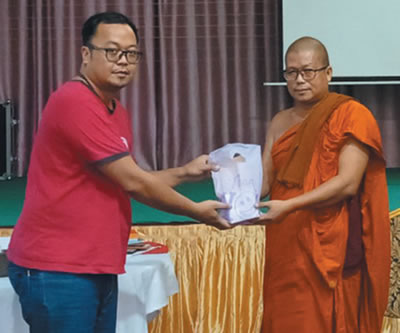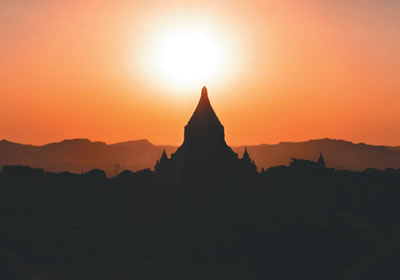
“Better Together,” was the theme for this year’s Interfaith Youth Leadership Camp 2024. It was conducted from June 7-9, 2024. It gathered about 43 youths from the five major religions present in Myitkyina, Myanmar. The Christian participants were the largest group with 20 participants (two from the Kachin Baptist Church, five from the Anglican Church and thirteen from the Roman Catholic Church). The Buddhist participants were the second biggest group with nine participants.

The Hindu and Sikh communities had five participants each. The Islamic community had four participants. We started the camp with inputs on conflict resolution. On the first day, a training on Social Cohesion was given. In the evening of the same day, Yaw Mon Kyaw, who is also a member of the Myitkyina Youth Mental Health Advocates group facilitated a mental health session. The following day, our guest, U Setthila, a Buddhist monk, gave a talk on Buddhism and later led a meditation exercise. After lunch, I presented a personal sharing of my own journey in interfaith dialogue where the ideas of friendship, food and faith were highlighted. We also introduced the Golden Rule presented by Michael Javier, a Filipino Columban lay missionary and the See-Judge-Act method presented by Philip Naw Seng, one of the leaders of the Catholic Student Action Myitkyina (CSAM).
Myitkyina is a beautifully diverse city but without social cohesion and dialogue this diversity can also lead to conflicts between communities within communities. It is important that we continue to find ways to work together because it is better together. The pilgrimage of interfaith dialogue among young people here in Myanmar continues until we reach our destination—a place of hope and peace for all the people of Myanmar.
On the last day of our camp, we went on a pilgrimage to five important places of worship here in Myitkyina, the St. Columban’s Church (Roman Catholic), Ram Janki Mandir (Hindu), Sikh Gurdwara (Temple), Panthay Masjid (Muslim), and lastly the Pain Nay Gauwng Monastery. Pilgrimage is an important ritual of many groups like Christians, Muslims, Hindus, Sikhs and Buddhists. Often it is a pilgrimage to a holy place to seek God’s blessings and forgiveness.
At the Buddhist monastery, we were greeted by U Ukkahtar Bhiwata the head monk, whom I have met a few times in the past. He welcomed us to the monastery and mentioned that everyone was welcome in his monastery. Th en the participants asked him some questions regarding Buddhism. One particular question was asked regarding the status of women in Buddhism in Myanmar. In many temples, women are forbidden to come up to the image of Buddha or touch the image. He mentioned that this is influenced by the culture and not necessarily a teaching of Buddha. In his monastery, he explained that everyone is welcome and that they do not discriminate. The Buddhist nuns then prepared tea and salad for the group.
 We sat down and chatted for a while before heading to our next destination, the Ram Janki Mandir also known as the Golden Temple. At the temple, we were greeted by two young Hindu ladies who mentioned that the Hindu priest or pundit and the community leader would arrive later. U Sanjay Kumar, the Hindu priest, explained the images found inside the temple. As he approached every image, he would ring the bell. He said this is to disengage the mind from ongoing thoughts thus making the mind more receptive. Bell ringing during prayer is said to help in controlling the ever-wandering mind and focusing on the deity. The sound of the bell is considered auspicious which welcomes divinity and dispels evil. It is also said that the bell produces the sound of “Om,” which Min Khant Tu, one of the participants shared as the universal name of the Lord.
We sat down and chatted for a while before heading to our next destination, the Ram Janki Mandir also known as the Golden Temple. At the temple, we were greeted by two young Hindu ladies who mentioned that the Hindu priest or pundit and the community leader would arrive later. U Sanjay Kumar, the Hindu priest, explained the images found inside the temple. As he approached every image, he would ring the bell. He said this is to disengage the mind from ongoing thoughts thus making the mind more receptive. Bell ringing during prayer is said to help in controlling the ever-wandering mind and focusing on the deity. The sound of the bell is considered auspicious which welcomes divinity and dispels evil. It is also said that the bell produces the sound of “Om,” which Min Khant Tu, one of the participants shared as the universal name of the Lord.
Straight after lunch, the group headed to the Muslim masjid which locals call the “Panthay Balee” which is actually the name of Chinese Muslims in Myanmar. We were met by their leaders at the Hall because only men were allowed to enter the main masjid or prayer hall of the Muslims. Women worship and pray in a separate room. I was glad to see Muft i Irfaan, a good friend among the leaders present. “Hkam kaja ai kun?” I asked him in the Kachin language. “Hkam kaja nga ai,” he responded. Muft i Irfaan is one of the few indigenous Kachins who is a Muslim. He is a Muslim scholar who studied in Egypt. He now teaches about Islam and the Arabic language. After the short interaction with the participants, the men followed to join him inside the mosque where he demonstrated the different prayer positions. Before entering the mosque, we all had to properly wash our feet and hands. This is called ablution or spiritual purification. After we said our thank you and goodbyes, he invited us to join them for the Eid al-Adha feast next week.
Finally, our last destination was the Sikh Gurdwara (Temple). Before entering we were asked to wear the headscarf for men and the veil for the women. We were welcomed by the Sikh Community leader U Raja. Ko Veve Singh, who is one of the focal persons of the Sikh youth community, explained some matters about the Sikh religion. He mentioned that in a Sikh gurdwara or temple, you will not find any images or statues. One will only find the sacred book called “Guru Granth Sahib.” U Raja with another youth started to play the tabla (drums) and the harmonium to sing a “kirtan” hymn to honor and worship the Lord. Th is brought me back to my days in Fiji, living among the Indo-Fijians. I was very happy.
Having visited all five sacred places, we all headed back to our camp venue and prepared for the final night of cultural food exchange and entertainment. The participants prepared various food and snacks. The Burmese Buddhists prepared dried fish salad, bean soup and pickled cabbage. The Kachin Christians prepared steamed lemon fish, fried rice and jam htu (pounded chilies). The combined Indian Hindus and the Punjabi Sikhs group prepared puri (deep-fried bread), “dal” or lentil soup and gulab jamon (dessert). The Indian Muslims prepare “samay,” a vermicelli pudding which is also a dessert usually offered during the Eid celebrations. After the delicious supper and having enjoyed the tastes of the different food and snacks, the group gradually started preparing for the closing program to show their different dancing and singing skills.
The night was long and fun as each group presented song and dance items highlighting the beautiful diversity in Myanmar. The last group to present was the Kachin Christians who led the participants in dancing the Manau. We danced in one line following one person at the head of the line.
Please continue to pray for the people of Myanmar and support our young people so we can continue to facilitate activities like this for our young people.
Columban Fr. Kurt Zion Pala lives and works in Myanmar.